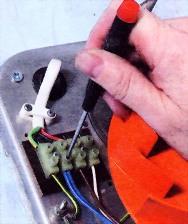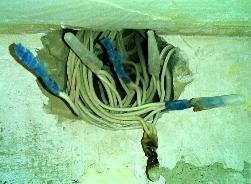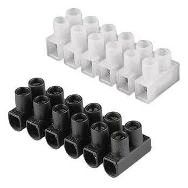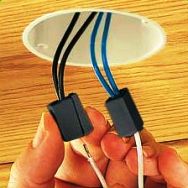Categories: Featured Articles » Electrician at home
Number of views: 212565
Comments on the article: 8
How to connect wires correctly
 An electrician is the science of contacts ... Almost every electrician knows, or at least heard this phrase. And the fact that this phrase is not taken from the ceiling, many learn in practice.
An electrician is the science of contacts ... Almost every electrician knows, or at least heard this phrase. And the fact that this phrase is not taken from the ceiling, many learn in practice.
Almost all problems associated with electricity arise due to congestion in the wiring, which is still quite relevant today, or because of poor contact in the soldering (dose) boxes or in the terminal boxes themselves (sockets, switches, fixtures) devices.
How is it better to connect the wires so that there is a reliable contact and so as not to have problems in the future? First, let's look at which compounds are most often found.
1) Twisting.
3) Soldering.
4) Welding.
5) Type self-locking terminals Wago.
6) Bolted connections.
Consider each of these methods in more detail.
 1) Twisting. This type of connection is perhaps the most common. Although, according to the PUE (electrical installation rules), twisting is not allowed. Here is an excerpt from this document:
1) Twisting. This type of connection is perhaps the most common. Although, according to the PUE (electrical installation rules), twisting is not allowed. Here is an excerpt from this document:
PUE: p2.1.21. Connection, branching and termination of conductors of wires and cables must be carried out by crimping, welding, soldering or clamping (screw, bolt, etc.) in accordance with applicable instructions.
How is things really going? Twists did, they do and will do. A wire twist made competently and in compliance with all the rules can last more than one decade.
The length of the twist should be at least 40-50 mm, the turns of the twisted wire should be laid tightly to each other. The end of the twist is bitten off by the wire cutters. It used to be called cold welding.
This type of connection was used to connect single-core aluminum wires. To date, almost no one uses aluminum wires for the installation of internal electrical wiring, but twists of copper wires are still in operation. The most responsible electricians twist from copper wires solder with tin-lead solder.
 2) Terminal (screw) connections. This type of connection has its pros and cons. The pluses include the fact that you can connect wires from different metals - aluminum and copper. This is perhaps the only right solution for connecting wires of different metals. But there is also one significant minus.
2) Terminal (screw) connections. This type of connection has its pros and cons. The pluses include the fact that you can connect wires from different metals - aluminum and copper. This is perhaps the only right solution for connecting wires of different metals. But there is also one significant minus.
Almost all electricians know about the "fluidity" of aluminum. And from time to time, the bolts, screws in the terminals must be squeezed in order to provide the necessary contact. In the case of using multi-wire wires, it is necessary to solder the ends of the wires or use special tubular lugs.
Also, the so-called "nuts" can be attributed to terminal connections. Structurally, they are a “pie” of three plates connected by bolts. The insulation of this design consists of two hemispheres, due to which, in fact, the name came about. But we will not dwell on the variety of terminal blocks, our goal is slightly different.
3) Soldering. This type of connection can perhaps be attributed to one of the reliable connections. Again, with skillful manufacture of soldering. This method is mainly used for connecting copper wires. But there are also special solders for soldering aluminum wires.
When using this method of connection, it is strictly forbidden to use acid-containing fluxes. At the end of the work, it is recommended to rinse the soldering place with gasoline or alcohol.
4) Welding. The most reliable of all types of connection. Only homogeneous metals may be welded. This type of connection can be called one of the relatively simple. To carry out the whole process, a step-down transformer, a special carbon rod-electrode, a little skill and straight arms are needed.And, importantly, this connection is recommended by the PUE.
 5) WAGO. This type of connection terminals pretty quickly took root among electricians. The popularity of this type of connection is simply explained - ease of installation, speed, does not require special devices, as is the case with soldering and welding.
5) WAGO. This type of connection terminals pretty quickly took root among electricians. The popularity of this type of connection is simply explained - ease of installation, speed, does not require special devices, as is the case with soldering and welding.
WAGO terminal blocks are available for various wire sizes and for different quantities. WAGO type terminal blocks are available for wires with a single conductor and for flexible wires. Inside the terminal block is a special paste that does not allow oxidation. Using these terminals, it is possible wire connection from various metals - aluminum and copper.
How reliable are these terminals, we find it difficult to weave. So, for example, there are terminals designed for wire cross-section of 4 mm square. Using simple calculations, we determine the current that this connection can withstand. It turns out about 40 A. Honestly, they doubt that spring contacts, with a long load, will not lose their remarkable properties.
PPE. Connecting insulating clamps. One of the connecting materials popular among installers. Arranged quite simply. A square steel wire twisted into a cone-shaped spiral. An insulating cap is put on top of the spiral. Inside, as in WAGO, there is a lubricant that prevents oxidation of the wires.
6) Bolted connections. Reliable enough and simple connection. When using aluminum wires, regular inspection of the joints is necessary, since aluminum has a flow property. It is allowed to connect aluminum and copper through an intermediate steel washer.
And in conclusion, I would like to note that it is worth taking the wire connections quite seriously, because the operation of the entire electrical system of the object depends on how well you make the connection, because it is not for nothing that they say - ELECTRICS - A SCIENCE ABOUT CONTACTS ...
Sergey Seromashenko
See also at e.imadeself.com
:
